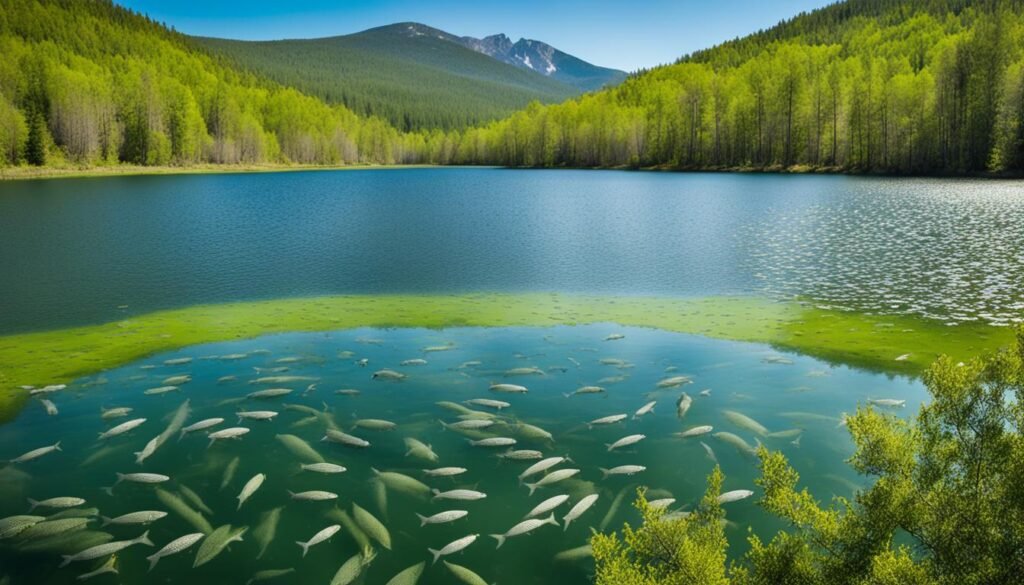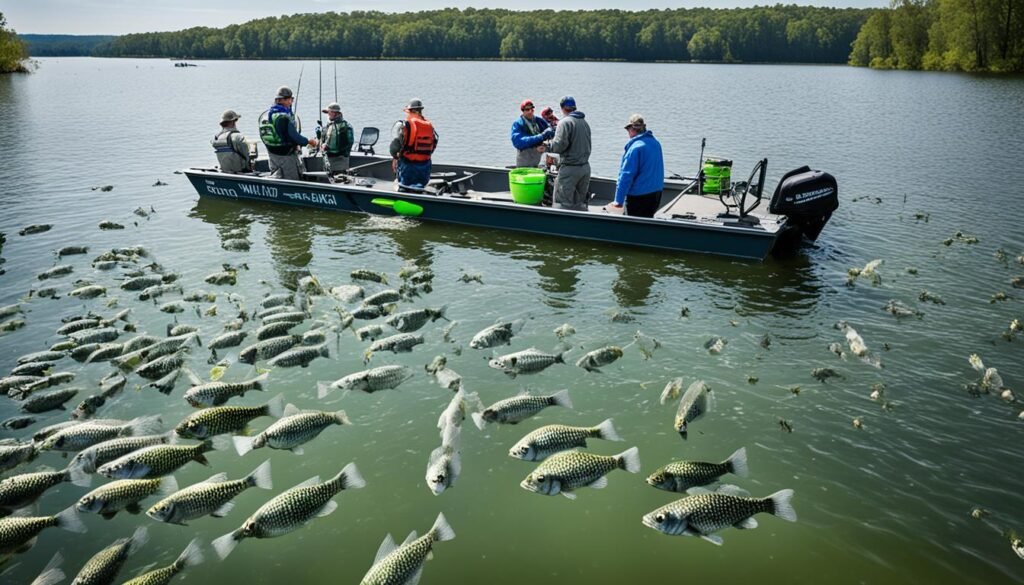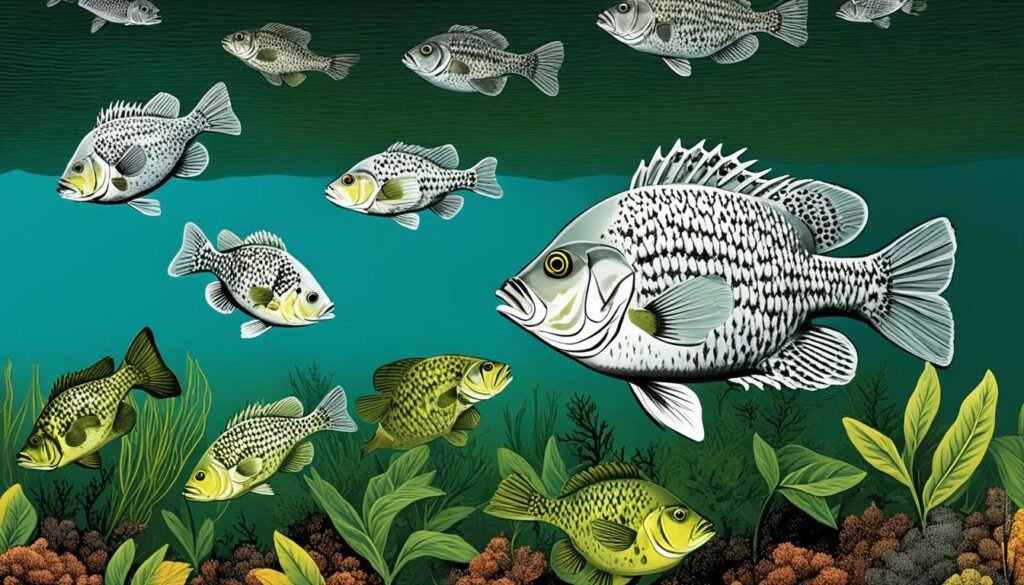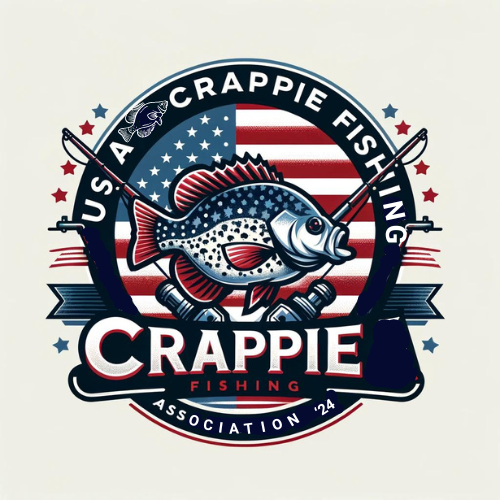Have you ever gone fishing at your favorite lake, expecting a peaceful day of casting your line and enjoying the tranquility of nature? Well, imagine arriving at the water’s edge only to be greeted by a horde of Crappie, completely dominating the lake. It may sound like a fisherman’s dream, but the rise of Crappie populations is causing quite a stir among anglers and environmentalists alike.
Crappie, a species of fish known for their delicious taste and exciting fight, are quickly becoming the rulers of lakes across the country. Their population explosion, driven by favorable environmental conditions and a lack of natural predators, has led to a situation where Crappie are taking over entire ecosystems. But why is this happening, and what can you do to catch them?
In this article, we’ll delve into the rise of Crappie populations and explore the impact they have on lake ecosystems. We’ll also provide you with essential fishing tips that will help you reel in these feisty fish. So, get ready to step into a world where Crappie are the kings of the lake.
Key Takeaways:
- Crappie populations are on the rise, leading to their domination of lakes across the country.
- The increase in Crappie populations can be attributed to favorable environmental conditions and a lack of natural predators.
- The dominance of Crappie can have a significant impact on the overall health of lake ecosystems, affecting native fish populations and the balance of the food chain.
- By employing effective fishing techniques and implementing proper management strategies, you can successfully catch Crappie and help maintain a balanced ecosystem.
- Educating anglers and lake users about the impact of Crappie domination is crucial for successful management and the preservation of native fish species.
The Rise of Crappie Population
The Crappie population has experienced a significant increase in recent years. This rise can be attributed to various factors, including favorable environmental conditions and lack of natural predators. As a result, lakes are experiencing an overpopulation of Crappie, which can negatively impact the overall ecosystem. It is important to manage Crappie populations to prevent any adverse effects on the lake’s ecosystem.
With the increasing Crappie population, it is essential to implement effective management strategies to maintain a balance in the ecosystem. Here are some ways to manage Crappie overpopulation:
- Size and Bag Limits: Implementing size and bag limits for anglers can help control the number of Crappie harvested from the lake. This ensures that the population remains within sustainable levels and prevents overfishing.
- Harvest Promotion: Encourage anglers to harvest Crappie by promoting their value as a food fish. By highlighting the delicious taste and culinary versatility of Crappie, more anglers may be incentivized to catch and consume them, helping to limit their numbers in the lake.
- Introducing Predators: Introducing natural predators, such as largemouth bass, can help keep Crappie populations in check. Bass feed on young Crappie, reducing their numbers naturally without the need for human intervention.
By implementing these management strategies, lakes can effectively control Crappie overpopulation and preserve the health of the ecosystem. It is crucial to strike a balance between allowing anglers to enjoy the thrill of catching Crappie and ensuring the long-term sustainability of the lake.
Impact on Lake Ecosystems
The dominance of Crappie in lakes can have a significant impact on the ecosystem. Crappie compete with other fish species for food and habitat, leading to a decline in native fish populations. Additionally, their feeding behaviors can disrupt the balance of the ecosystem, affecting the abundance of aquatic plants and invertebrates. Lake managers must implement effective ecosystem management strategies to mitigate the negative consequences of Crappie domination.
Ecosystem Disruption
When Crappie become dominant in a lake, they compete with native fish species for food resources such as small insects, crustaceans, and small fish. This competition can result in reduced food availability for native species, leading to declines in their populations. Crappie’s voracious appetites and rapid growth rates give them an advantage over other fish, exacerbating the competition and further impacting the ecosystem.
Altered Habitat
Crapie are known to prefer specific habitat types, such as submerged vegetation, fallen trees, and brush piles. Their preference for these areas can cause significant changes in the lake’s habitat structure.
As Crappie dominate these preferred habitats, they can crowd out other fish species that rely on the same areas for shelter and reproduction. This displacement can disrupt the natural balance of the ecosystem and negatively impact the overall biodiversity of the lake.
Effects on Aquatic Plants and Invertebrates
The feeding behaviors of Crappie can also impact the abundance of aquatic plants and invertebrates in the lake. Crappie are opportunistic predators that feed on a variety of organisms, including small crustaceans and insects.
As Crappie consume these organisms, the balance between prey and predator is disrupted, potentially leading to population declines among aquatic plants and invertebrates. This disruption can have cascading effects throughout the food web, affecting other organisms that depend on these resources for survival.
Lake managers play a crucial role in managing the impact of Crappie domination on the lake ecosystem. By implementing effective ecosystem management strategies, such as habitat restoration and monitoring programs, they can help maintain a healthy balance between Crappie populations and the overall ecosystem.

Effective Crappie Fishing Techniques
When it comes to catching Crappie, employing the right techniques can make all the difference. These tips will help you increase your chances of a successful fishing trip and reel in those prized Crappie.
1. Use Beetle Spins and Jig and Twisters as Search Baits
To locate schools of Crappie, try using beetle spins and jig and twisters as search baits. These lures have proven to be highly effective in attracting Crappie and enticing them to strike. Cast them near submerged structures or areas with vegetation, which Crappie tend to inhabit.
2. Slow Down with Crappie Minnows
Once you’ve located a school of Crappie, slow down your fishing approach. Switch to using live crappie minnows fished under a bobber. This technique allows you to present the bait at the right depth and mimics the natural movement of the minnows, which is irresistible to hungry Crappie.
3. Fish During Evenings Near Weedlines and Weedbeds
Fishing for Crappie during evenings can be highly productive. As the sun starts to set, Crappie become more active and tend to move into shallower areas near weedlines and weedbeds in search of prey. Cast your bait near these prime feeding areas to entice Crappie to bite.
Pro Tip: “Remember to adjust your fishing techniques based on the current weather conditions and the behavior of the Crappie. They can be more active during cloudy or slightly windy days.”
By employing these effective Crappie fishing techniques, you’ll improve your chances of landing a trophy-worthy catch. Remember to adapt your approach based on the prevailing conditions and the behavior of the fish. Happy fishing!
Controlling Crappie Overpopulation
Managing Crappie overpopulation is crucial to maintain a balanced ecosystem in lakes. To control Crappie populations, various approaches can be taken:
- Implementing Size and Bag Limits: By setting specific regulations on the size and quantity of Crappie that anglers are allowed to catch and keep, lake managers can help control their population growth. This helps ensure that the Crappie population remains within sustainable levels.
- Promoting Harvesting: Encouraging anglers to harvest Crappie can also assist in managing their population. Educating anglers about the benefits of harvesting and the responsible ways to do so can contribute to a healthy balance in the lake’s ecosystem.
- Introducing Natural Predators: Introducing natural predators, such as largemouth bass, can aid in controlling the Crappie population. Largemouth bass prey on Crappie, helping to keep their numbers in check.
- Population Control Measures: In extreme cases, lake managers may need to implement more direct population control measures, such as electrofishing or netting. These methods can be used to remove excess Crappie from the lake to restore balance.

“To maintain a balanced ecosystem, it is essential to control the overpopulation of Crappie in lakes. By implementing size and bag limits, promoting harvesting, introducing natural predators, and considering population control measures, lake managers can effectively manage and regulate the Crappie population.”
Environmental Impacts of Crappie Domination
The domination of Crappie in lakes can have a significant impact on the environment. Their feeding habits can disrupt the natural food chain and lead to imbalances in the ecosystem. Moreover, the increased competition for resources can negatively affect the populations of other fish species. It is important to consider the environmental impacts of Crappie domination and take necessary measures to maintain a healthy ecosystem.

Strategies for Successful Crappie Fishing
When it comes to catching Crappie, employing effective strategies can make a significant difference in your fishing success. Here are some expert tips to help you improve your chances of landing a great catch:
1. Target Sunken Islands
Crappie are known to congregate around sunken islands as these structures provide them with ample food sources and cover. Look for submerged humps or drop-offs on your fishfinder and focus your fishing efforts in those areas. By strategically positioning your bait near these structures, you increase your odds of attracting Crappie.
2. Use Larger Minnows for Trophy-Sized Catches
If you’re looking to hook trophy-sized Crappie, consider using larger minnows as bait. These bigger baitfish attract larger fish and can significantly increase your chances of reeling in a prized catch. Combine this strategy with accurate casting around structure-rich areas for the best results.
3. Time Your Fishing Sessions
Timing is crucial when it comes to Crappie fishing. As a general rule, Crappie tend to be more active during specific times of the day, such as early morning, late evening, and even at night. Fishing during these periods increases your chances of encountering feeding Crappie. Be sure to check local fishing reports or consult with experienced anglers to determine the optimal times for Crappie activity in your area.
4. Locate Key Areas for Crappie Congregation
Identifying key areas where Crappie are likely to gather is essential for a successful fishing trip. Look for weedbeds, submerged trees, and other types of underwater structure, as Crappie tend to seek shelter and hunt for prey in these locations. By casting your bait near these hotspots, you increase your chances of enticing Crappie to bite.
So, whether you’re a seasoned angler or just starting out, use these strategies to enhance your Crappie fishing experience. Remember to adjust your techniques based on the prevailing conditions and be patient as Crappie can be finicky at times. Happy fishing!
| Crappie Fishing Strategies | Benefits |
|---|---|
| Targeting sunken islands | – Increases chances of finding Crappie – Provides ample food and cover |
| Using larger minnows | – Attracts trophy-sized Crappie – Increases chances of landing prized catches |
| Timing fishing sessions | – Capitalizes on peak activity periods – Increases encounters with feeding Crappie |
| Locating key areas | – Targets high-concentration Crappie zones – Enhances chances of success |
Monitoring and Research Efforts
Efficient management of Crappie populations in lakes necessitates monitoring and research activities. Fisheries agencies and research organizations play a pivotal role in conducting studies to gather valuable data on various aspects of Crappie populations. These studies focus on tracking population trends, growth rates, and reproductive patterns, enabling scientists to gain a deeper understanding of Crappie behavior and develop effective strategies for maintaining their populations at sustainable levels.
The Future of Crappie Management
As Crappie populations continue to rise, it is crucial to implement effective management strategies to ensure the preservation of the overall health of lake ecosystems. Collaborative efforts between lake managers and fisheries agencies are essential in developing comprehensive management plans that address the increasing Crappie control in lakes. These management plans should incorporate a range of strategies, including size and bag limits, habitat improvements, and population control measures.
By setting appropriate size and bag limits for anglers, the Crappie population can be regulated, preventing overfishing and promoting sustainable harvesting practices. It is also important to focus on habitat improvements to provide a suitable environment for other fish species and maintain a diverse ecosystem. Creating and enhancing spawning areas, maintaining water quality, and preserving natural habitats are vital steps in ensuring the long-term survival of native fish populations.
A significant aspect of Crappie management is the implementation of population control measures. Conducting electrofishing or netting operations can help reduce Crappie numbers in lakes, providing relief to native fish species struggling to compete with the growing Crappie population. The careful and strategic removal of excess Crappie can restore balance to the ecosystem and promote the growth and well-being of other fish species.
Effective management strategies are key to achieving a harmonious coexistence between Crappie populations and the overall health of lake ecosystems.
Benefits of Effective Crappie Management
Implementing successful Crappie management strategies can yield numerous benefits for both the environment and anglers. By maintaining healthy Crappie populations, the ecosystem remains balanced, ensuring the preservation of native fish species and maintaining the overall diversity of aquatic life. Anglers also benefit from the management efforts as they can enjoy sustainable, fruitful fishing experiences for years to come.
To summarize, the future of Crappie management lies in the careful balance between Crappie control and the preservation of lake ecosystems. By implementing comprehensive management plans, lake managers and fisheries agencies can ensure the long-term viability of both Crappie populations and the overall health of the lake. With effective strategies in place, anglers and nature enthusiasts can continue to appreciate the beauty and bounty of our lakes.
Supporting Native Fish Species
While the domination of Crappie in lakes can pose challenges for native fish populations, it is crucial to prioritize the conservation and support of these species. By implementing effective lake ecosystem management strategies, both lake managers and anglers can work together to create favorable conditions for native fish to thrive.
Maintaining suitable habitat is essential for supporting native fish populations. This can include preserving natural spawning areas, protecting shoreline vegetation, and ensuring the availability of suitable food sources. By taking proactive measures to protect and enhance the native fish habitat, the overall resilience of the lake ecosystem can be improved.
Reducing pollution is another crucial aspect of lake ecosystem management. By minimizing pollution from various sources such as agricultural runoff and wastewater discharge, the water quality can improve, providing a healthier environment for native fish species to thrive and reproduce.
Protecting spawning areas is of utmost importance in supporting native fish populations. Designating and safeguarding spawning zones during critical breeding seasons can help prevent disturbance and habitat degradation. This allows native fish species to successfully reproduce, ensuring the sustainability of their populations.
In combination, these efforts contribute to the overarching goal of maintaining a healthy and balanced lake ecosystem. By supporting and conserving native fish species, the negative impacts of Crappie domination can be mitigated, allowing for the coexistence of various fish populations within the lake.
Benefits of Supporting Native Fish Species
Supporting the native fish species within a lake ecosystem brings with it a multitude of benefits. Firstly, native fish species are a vital part of the natural food chain, contributing to the overall balance and stability of the ecosystem.
Additionally, native fish species often play crucial roles in controlling population levels of certain aquatic organisms, preventing excessive growth or spread of invasive species that may disrupt the ecosystem balance. Actively supporting native fish populations can help maintain a harmonious and healthy ecological system.
Furthermore, many native fish species have cultural and historical significance, often serving as important game fish desired by anglers. By conserving these species, the fishing experience can be enriched, offering diverse opportunities for anglers while ensuring sustainable recreational fishing practices.
Comparison of Crappie and Native Fish Species
| Characteristic | Crappie | Native Fish Species |
|---|---|---|
| Feeding Habits | Primarily feed on small fish, insects, and crustaceans | Diverse feeding habits, varying from herbivorous to omnivorous diets |
| Reproductive Strategy | Relatively high reproductive output, producing large numbers of eggs | Varies between species, with different spawning behaviors and egg production rates |
| Ecological Impact | Compete with native fish for resources, potentially leading to reduced abundance of certain species | Contribute to the overall stability of the ecosystem, maintaining a balanced predator-prey relationship |
| Cultural Value | Highly sought after by anglers for sport fishing | Hold cultural significance, often representing local fishery traditions and recreational opportunities |
“Supporting and conserving native fish species is crucial for maintaining the health and biodiversity of lake ecosystems. By implementing effective habitat management practices, reducing pollution, and protecting spawning areas, we can ensure the long-term sustainability of our native fish populations. Together, we can strike a balance between the dominance of Crappie and the preservation of our diverse aquatic communities.”
Educating Anglers and Lake Users
Educating anglers and lake users is a crucial component of effective lake ecosystem management. By providing information about the impact of Crappie domination and promoting sustainable fishing practices, we can ensure the long-term health and balance of our lakes.
The awareness of angler’s role in maintaining the ecosystem is the first step towards responsible fishing practices. By understanding how their actions can affect the delicate balance of the lake, anglers can make informed decisions that contribute to the overall health of the ecosystem.
One effective way to educate anglers and lake users is through public outreach programs. These programs can include workshops, seminars, and hands-on training sessions that focus on the importance of sustainable fishing practices and the role of Crappie in the lake ecosystem. By providing anglers with the knowledge and tools they need, we can empower them to become stewards of the lakes they enjoy.
“Education is the most powerful weapon which you can use to change the world.” – Nelson Mandela
Fishing tournaments can also serve as an opportunity for education. By incorporating educational components into these events, such as informational booths or guest speakers, anglers can learn about the impact of Crappie domination and the importance of responsible fishing practices. These tournaments can provide a platform to promote sustainable fishing practices and create a sense of camaraderie among anglers who are passionate about protecting the lake ecosystem.
Another effective method of education is the distribution of educational materials. Brochures, pamphlets, and online resources can provide anglers and lake users with vital information about responsible fishing practices, the importance of invasive species management, and the overall health of the lake ecosystem. These materials can be made available at fishing supply stores, visitor centers, and online platforms to ensure accessibility to a wide audience.
Benefits of Educating Anglers and Lake Users
When anglers and lake users are educated about the impact of Crappie domination and the importance of sustainable fishing practices, it leads to several benefits:
- Preservation of native fish populations
- Maintenance of a balanced ecosystem
- Reduction in the negative effects of invasive species
- Promotion of responsible fishing practices
| Benefits of Educating Anglers and Lake Users | Impact |
|---|---|
| Preservation of native fish populations | Ensures the continued existence of diverse fish species and the overall health of the ecosystem. |
| Maintenance of a balanced ecosystem | Helps maintain the delicate balance of the lake ecosystem by preventing the overpopulation of Crappie and the subsequent decline of native fish populations. |
| Reduction in the negative effects of invasive species | By educating anglers about the impact of invasive species, such as Crappie domination, it allows them to take steps towards managing their populations and minimizing their negative effects on the ecosystem. |
| Promotion of responsible fishing practices | Encourages anglers to practice sustainable fishing techniques, follow regulations and guidelines, and consider the long-term effects of their actions on the lake ecosystem. |
By educating anglers and lake users, we can foster a sense of stewardship and responsibility towards our lakes and their ecosystems. Through ongoing education efforts, we can ensure the preservation of native fish populations, the maintenance of a balanced ecosystem, and the enjoyment of our lakes for generations to come.
Conclusion
The recent rise of Crappie populations and their increasing domination in lakes across the country has both positive and negative implications. On one hand, Crappie fishing can be an exciting and rewarding experience for anglers, attracting fishing enthusiasts to these lakes. However, it is crucial to manage Crappie populations effectively to prevent any adverse effects on the lake ecosystem and native fish species.
By implementing proactive management strategies, such as size and bag limits for anglers, promoting the harvest of Crappie, and introducing natural predators like largemouth bass, we can control and maintain Crappie populations at sustainable levels. Additionally, supporting the native fish species by creating suitable habitats and reducing pollution is essential for preserving the overall health and biodiversity of our lakes.
To ensure long-term sustainability, it is vital to educate anglers and other lake users about the impact of Crappie domination on the ecosystem. By raising awareness and providing information about sustainable fishing practices, we can encourage responsible fishing practices that contribute to the preservation of our lakes. Public outreach programs, fishing tournaments, and educational materials play a crucial role in instilling a sense of stewardship among lake users.
In conclusion, while the rise of Crappie populations and their domination in lakes may present challenges, it is possible to strike a balance that allows us to enjoy the excitement of Crappie fishing while preserving the health and biodiversity of our lakes. Through effective management strategies, support for native fish populations, and education, we can ensure that Crappie continue to thrive without causing significant harm to the lake ecosystem.
